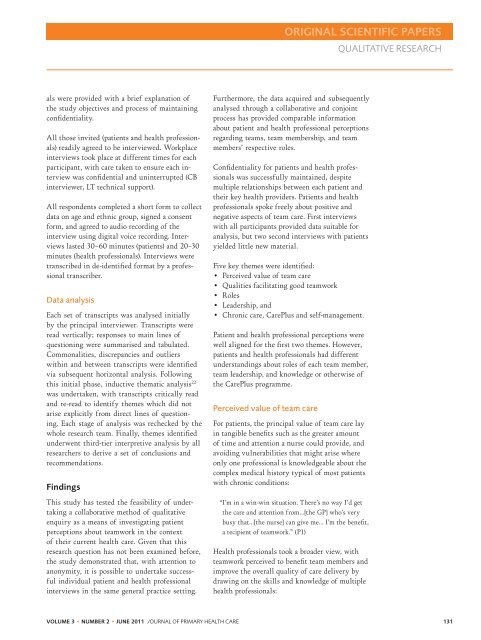single PDF of the entire issue - The Royal New Zealand College of ...
single PDF of the entire issue - The Royal New Zealand College of ...
single PDF of the entire issue - The Royal New Zealand College of ...
Create successful ePaper yourself
Turn your PDF publications into a flip-book with our unique Google optimized e-Paper software.
ORIGINAL SCIENTIFIC PAPErS<br />
quaLitative research<br />
als were provided with a brief explanation <strong>of</strong><br />
<strong>the</strong> study objectives and process <strong>of</strong> maintaining<br />
confidentiality.<br />
All those invited (patients and health pr<strong>of</strong>essionals)<br />
readily agreed to be interviewed. Workplace<br />
interviews took place at different times for each<br />
participant, with care taken to ensure each interview<br />
was confidential and uninterrupted (CB<br />
interviewer, LT technical support).<br />
All respondents completed a short form to collect<br />
data on age and ethnic group, signed a consent<br />
form, and agreed to audio recording <strong>of</strong> <strong>the</strong><br />
interview using digital voice recording. Interviews<br />
lasted 30–60 minutes (patients) and 20–30<br />
minutes (health pr<strong>of</strong>essionals). Interviews were<br />
transcribed in de-identified format by a pr<strong>of</strong>essional<br />
transcriber.<br />
Data analysis<br />
Each set <strong>of</strong> transcripts was analysed initially<br />
by <strong>the</strong> principal interviewer. Transcripts were<br />
read vertically; responses to main lines <strong>of</strong><br />
questioning were summarised and tabulated.<br />
Commonalities, discrepancies and outliers<br />
within and between transcripts were identified<br />
via subsequent horizontal analysis. Following<br />
this initial phase, inductive <strong>the</strong>matic analysis 22<br />
was undertaken, with transcripts critically read<br />
and re-read to identify <strong>the</strong>mes which did not<br />
arise explicitly from direct lines <strong>of</strong> questioning.<br />
Each stage <strong>of</strong> analysis was rechecked by <strong>the</strong><br />
whole research team. Finally, <strong>the</strong>mes identified<br />
underwent third-tier interpretive analysis by all<br />
researchers to derive a set <strong>of</strong> conclusions and<br />
recommendations.<br />
Findings<br />
This study has tested <strong>the</strong> feasibility <strong>of</strong> undertaking<br />
a collaborative method <strong>of</strong> qualitative<br />
enquiry as a means <strong>of</strong> investigating patient<br />
perceptions about teamwork in <strong>the</strong> context<br />
<strong>of</strong> <strong>the</strong>ir current health care. Given that this<br />
research question has not been examined before,<br />
<strong>the</strong> study demonstrated that, with attention to<br />
anonymity, it is possible to undertake successful<br />
individual patient and health pr<strong>of</strong>essional<br />
interviews in <strong>the</strong> same general practice setting.<br />
Fur<strong>the</strong>rmore, <strong>the</strong> data acquired and subsequently<br />
analysed through a collaborative and conjoint<br />
process has provided comparable information<br />
about patient and health pr<strong>of</strong>essional perceptions<br />
regarding teams, team membership, and team<br />
members’ respective roles.<br />
Confidentiality for patients and health pr<strong>of</strong>essionals<br />
was successfully maintained, despite<br />
multiple relationships between each patient and<br />
<strong>the</strong>ir key health providers. Patients and health<br />
pr<strong>of</strong>essionals spoke freely about positive and<br />
negative aspects <strong>of</strong> team care. First interviews<br />
with all participants provided data suitable for<br />
analysis, but two second interviews with patients<br />
yielded little new material.<br />
Five key <strong>the</strong>mes were identified:<br />
• Perceived value <strong>of</strong> team care<br />
• Qualities facilitating good teamwork<br />
• Roles<br />
• Leadership, and<br />
• Chronic care, CarePlus and self-management.<br />
Patient and health pr<strong>of</strong>essional perceptions were<br />
well aligned for <strong>the</strong> first two <strong>the</strong>mes. However,<br />
patients and health pr<strong>of</strong>essionals had different<br />
understandings about roles <strong>of</strong> each team member,<br />
team leadership, and knowledge or o<strong>the</strong>rwise <strong>of</strong><br />
<strong>the</strong> CarePlus programme.<br />
Perceived value <strong>of</strong> team care<br />
For patients, <strong>the</strong> principal value <strong>of</strong> team care lay<br />
in tangible benefits such as <strong>the</strong> greater amount<br />
<strong>of</strong> time and attention a nurse could provide, and<br />
avoiding vulnerabilities that might arise where<br />
only one pr<strong>of</strong>essional is knowledgeable about <strong>the</strong><br />
complex medical history typical <strong>of</strong> most patients<br />
with chronic conditions:<br />
“I’m in a win-win situation. <strong>The</strong>re’s no way I’d get<br />
<strong>the</strong> care and attention from…[<strong>the</strong> GP] who’s very<br />
busy that…[<strong>the</strong> nurse] can give me… I’m <strong>the</strong> benefit,<br />
a recipient <strong>of</strong> teamwork.” (P1)<br />
Health pr<strong>of</strong>essionals took a broader view, with<br />
teamwork perceived to benefit team members and<br />
improve <strong>the</strong> overall quality <strong>of</strong> care delivery by<br />
drawing on <strong>the</strong> skills and knowledge <strong>of</strong> multiple<br />
health pr<strong>of</strong>essionals:<br />
VOLUME 3 • NUMBER 2 • JUNE 2011 J OURNAL OF PRIMARY HEALTH CARE 131

















